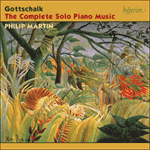After his first sojourn on Cuba (1854/55), Gottschalk returned in 1857 and, having subsequently spent two years meandering round the Caribbean, lived there for two years from November 1859. Among his many friends, the most talented and cosmopolitan was the reclusive pianist Nicolás Ruiz Espadero (1832–1890). A substantial inheritance enabled the eccentric Cuban to survive in the family home for forty years with nothing but a piano, piles of manuscript paper and innumerable cats. Gottschalk and he became inseparable and realising that many of Gottschalk’s compositions had never been written down, Espadero took upon himself the role of amanuensis, resolving to commit them to paper and preserve them for posterity. It was a conscious re-enactment of the role Julian Fontana had performed for Chopin when he looked after the affairs of the great composer between 1836 and 1841, becoming his copyist, secretary and factotum. (In a further example of trans-continental pianistic cross-pollination, Fontana (1810–1869), the dedicatee of Chopin’s two
Polonaises Op 40, and himself a Polish pianist and composer, lived in Havana and New York from 1842 to 1852.) At Espadero’s suggestion, Gottschalk began a correspondence with Fontana in Paris and it was to Fontana that Gottschalk dedicated two new pieces,
La Gitanella, Op 35 and
Fantôme De bonheur, Op 36. ‘The Gypsy Dance’ is indeed ‘characteristic’ Gottschalk, its attractive G minor opening subject (in 68) framing a more languid section in G major.
from notes by Jeremy Nicholas © 2000
Après ce premier séjour (1854/5), Gottschalk retrouva Cuba en 1857 puis passa deux ans à errer dans les Caraïbes avant de revenir s’établir sur l’île, où il vécut deux ans, à partir de novembre 1859. Le plus talentueux et le plus cosmopolite de ses nombreux amis fut le pianiste reclus Nicolás Ruiz Espadero (1832–1890). Un confortable héritage permit à cet excentrique Cubain de survivre quarante ans dans la demeure familiale avec, en tout et pour tout, un piano, des piles de papier à musique et d’innombrables chats. Gottschalk et lui devinrent inséparables et, réalisant que maintes compositions de son ami n’avaient jamais été consignées, Espadero, résolu à les coucher sur le papier et à les préserver pour la postérité, prit sur lui de devenir secrétaire-copiste. Ce faisant, il reproduisit consciemment le rôle que Julian Fontana avait tenu auprès de Chopin entre 1836 et 1841, et devint, à son tour, copiste, secrétaire et factotum. (Preuve supplémentaire de cette pollinisation croisée, pianistique et transcontinentale, Fontana [1810–1869], dédicataire des deux
Polonaises, op. 40 de Chopin mais aussi pianiste-compositeur polonais, vécut à la Havane et à New York de 1842 à 1852.) Sur la suggestion d’Espadero, Gottschalk entra en correspondance avec Fontana, à Paris, et ce fut à lui qu’il dédia deux nouvelles pièces,
La Gitanella, op. 35 et
Fantôme de bonheur, op.36.
La Gitanella est, en définitive, typiquement gottschalkienne, son attrayant sujet d’ouverture en sol mineur (à 68) encadrant une section en sol majeur, davantage langoureuse.
extrait des notes rédigées par Jeremy Nicholas © 2000
Français: Hypérion
Nach seinem ersten Kuba-Aufenthalt (1854/55) kehrte Gottschalk 1857 auf die Insel zurück und blieb dort, nachdem er zwei Jahre lang die Karibik bereist hatte, ab November 1859 zwei weitere Jahre. Der begabteste und kosmopolitischste seiner zahlreichen Freunde war der menschenscheue Pianist Nicolás Ruiz Espadero (1832–1890). Eine beachtliche Erbschaft ermöglichte es dem exzentrischen Kubaner, vierzig Jahre lang im Haus der Familie zu verleben, mit nichts als einem Klavier, Stapeln von Manuskripten und unzähligen Katzen. Gottschalk und er wurden unzertrennlich, und als ihm klar wurde, daß viele von Gottschalks Kompositionen niemals niedergeschrieben worden waren, übernahm Espadero entschlossen die Rolle des Sekretärs, um sie zu Papier zu bringen und für die Nachwelt zu bewahren. Es war eine bewußte Nachahmung der Rolle, die Julian Fontana für Chopin gespielt hatte, als er sich zwischen 1836 und 1841 um die Angelegenheiten des großen Komponisten gekümmert hatte und sein Kopist, Sekretär und Faktotum wurde. (Um ein weiteres Beispiel eines transkontinentalen pianistischen Austauschs zu nennen: Fontana (1810–1869), dem Chopins zwei
Polonaisen Op. 40 gewidmet sind und der selbst ein polnischer Pianist und Komponist war, lebte von 1842 bis 1852 in Havanna und New York.) Auf Espaderos Anregung begann Gottschalk, mit Fontana in Paris zu korrespondieren, und es war Fontana, dem Gottschalk zwei neue Stücke widmete:
La Gitanella Op. 35 und
Fantôme de bonheur Op. 36. Der „Zigeunertanz“ ist insofern typisch für Gottschalk, als sein reizvolles erstes Thema in g-Moll (im 68-Takt) einen getrageneren Abschnitt in G-Dur einrahmt.
aus dem Begleittext von Jeremy Nicholas © 2000
Deutsch: Anne Steeb/Bernd Müller


 Gottschalk: The Complete Solo Piano Music
Gottschalk: The Complete Solo Piano Music
